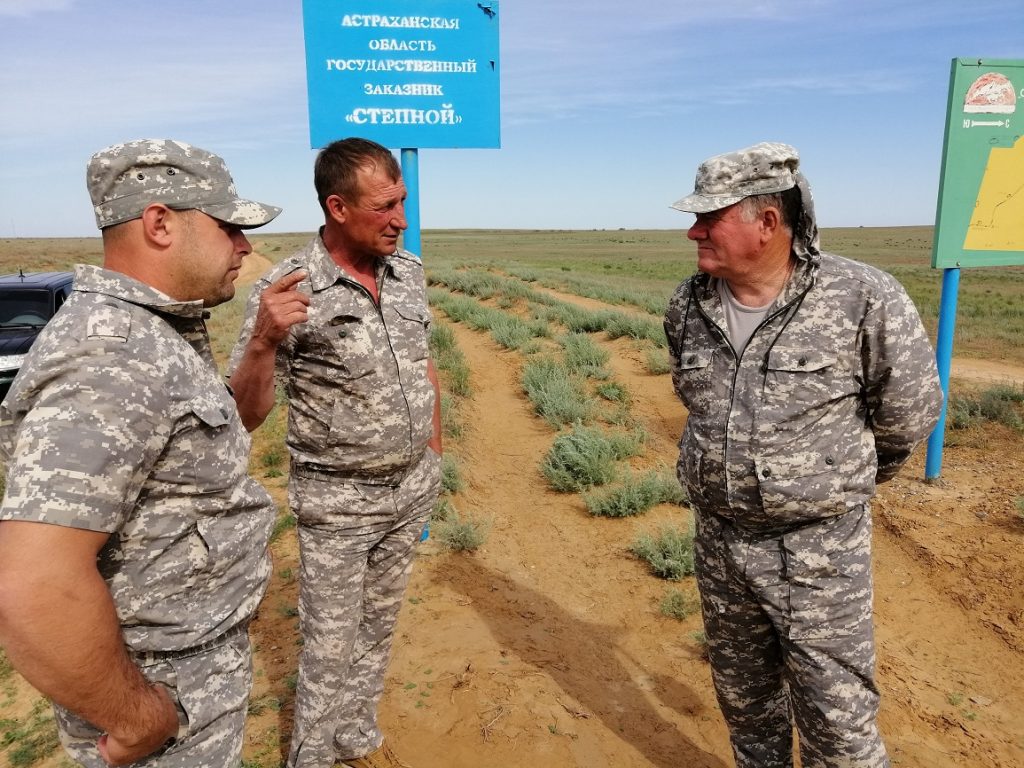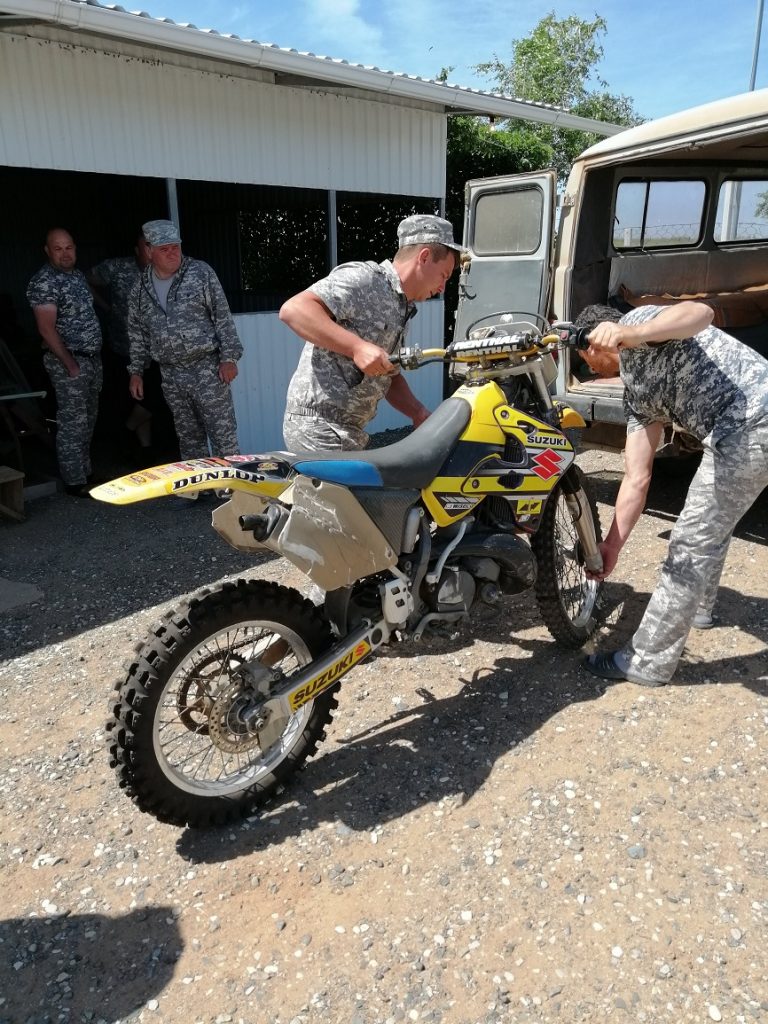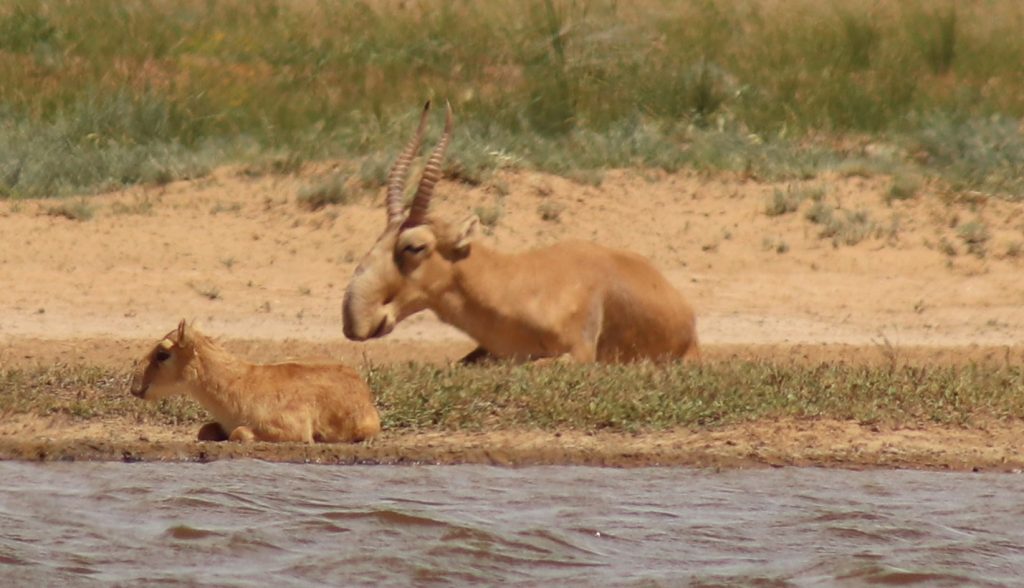Stepnoy Reserve, Astrakhan region, Russia, May 2019
During our recent trip, we had a chance to visit Stepnoy Reserve and have a quick talk with the director of the Reserve Vladimir Kalmykov and his wife Galina. Love, saigas, fighting with bad people – this story is full of deep romance and dedication.
Во время недавней поездки нам посчастливилоь посетить Заказник Степной и поговорить с директором заказника Владимиром Калмыковым и его женой Галиной. Любовь, сайгаки, борьба с плохими людьми – эта история полна глубокой романтики и самоотверженности.

V. Kalmykov: The reserve was founded on April 5, 2000, I started working in 2000 as a motorcycle ranger. I have been working as a ranger all my life since 1988. When Stepnoy was established, I was a hunting ranger in Liman hunting state agency. The Reserve was created specifically to save the saiga, I had the experience, and the head of the district (Liman district) asked me to go there to work and help. In the beginning, we used my personal UAZ (Russian jeep) for patrolling. Later our Governor, who created the Reserve, allocated funds to us, we bought cars, motorcycles and continued working. At that time, I also had my own business — ponds to breed fish. We bred fish there, fished out, sold it, paid taxes, everything had been done properly. In 2013, Anatoly Khludnev (first director of Stepnoy), moved to work to another Protected Area. Then I became a director of Stepnoy. And since then I had no time for ponds, they are in my property still, but they are just ‘sleeping’. We caught fish last time in 2013, paid taxes and everything, and since then I don’t deal with them, they stand in a dormant state. While I am a director in the Reserve, I do not do this, because it is impossible, and there is no time. Here (in the Reserve) you have to be all the time, otherwise, there is no need to take this job at all.
В. Калмыков: Заказник был основан 5 апреля 2000 года, я начал работать с 2000, инспектором-мотоциклистом. Я всю жизнь работаю инспектором с 88 года, когда заказник оргназиовали, я был охотоведом в Лиманском охотхозяйстве. Заказник создали специально, чтобы сохранить сайгака, у меня был опыт, и меня попросил глава района пойти туда работать и помочь. Первое время мы ездили на моём личном УАЗе охраняли. Потом нам наш губернатор ныне покойный, который создал Заказник, выделил средства, мы купили автомобили, мотоциклы и работали. У меня были пруды, чтобы рыбу разводить, еще с колхозных времен. Мы там разводили рыбу, вылавливали, платили налоги, всё как положено. В 2013 году Хлуднев ныне покойный перешел работать в другое ООПТ. Тогда я стал директором работать. А поскольку на пруды времени нет, они у меня в собственности, вот мы выловили в 2013 году рыбу, заплатили налоги и всё, с тех пор я ими не занимаюсь, так они стоят, в спящем состоянии. Пока я директор, я этим не занимаюсь, т.к. и нельзя, да и времени нет. Тут (в Заказнике) надо быть всё время, а иначе и браться не надо.
G. Kalmykova: I used to have nothing to do with environmental work. I am an accountant, then graduated, became an economist-accountant. I worked in the district administration (Liman district) in the economics department. Vladimir Georgievich, when we met in 2009, told me a lot about how everything goes here in the Reserve. In 2010, I visited Reserve for the first time, calving just passed. And I saw saigas for the first time then, although I live here, I am local, but then I saw them for the first time. And when I saw them, I fell in love with them. Volodya bought me a small photo camera. And from that moment, there was no going back. Reserve and Volodya have conquered my heart completely. And it became very interesting, especially when we are together, when we support and inspire each other, all this is even more interesting. So, this is the business of our family, and its cause also. And our team is very good, the rangers are all professionals and just good guys.
Г. Калмыкова: Раньше я вообще никак не была связана с природоохранной работой. Я бухгалтер, потом получила высшее образование, стала экономист-бухгалтер. Я работала в районной админстрации в экономическом отделе. Владимир Георгиевич, когда мы познакомились в 2009 году, много рассказывал о том, как здесь в Заказнике. В 2010 году я впервые тут побывала, как раз прошёл отёл. И я впервые тогда увидела сайгаков, хотя я живу здесь, я местная, но тогда я их увидела первый раз. И когда я их увидела, я в них влюбилась. Фотоаапарат мне Володя тогда купил маленький. И всё, пути назад не было. Меня и Заказник покорил, и Володя. И стало очень интересно, тем более вдвоём, когда друг друга поддерживаем и вдохновляем, ещё интереснее. Так что это дело нашей семьи, на котором она, можно сказать, и возникла. И коллектив у нас очень хороший, инспектора все профессионалы и просто хорошие ребята.
V. Kalmykov: Yes, our rangers are the best ones. We have 10 rangers, they are on duty at the cordon for 3 days shift, all year round. The Reserve is never left unattended. And even when we write a report for the year, we are asked — how many raids you had? That’s how many days in a year, so many raids we’ve done – exactly 365. They don’t believe us, they say, maybe you have 280 raids or something else? I say – no, we have raids every day. 3 people in the shift. One on the cordon, two on the raid, one of them is a motorcyclist. During the periods when saiga left the territory — because it always moves here and there, from our Reserve to the “Black Lands” (neighboring Reserve) and back — then rangers make fewer raids per day. And if saiga came to us, then the shift is 6 people to make raids more often. But anyway, every day rangers are in the Reserve, and they make a raid. Every shift hands the cordon over – everything is washed, cleaned, the floors are wiped, it’s for sure. At first, of course, it was difficult to get everyone used to it. At first, when Reserve was only established, everyone lived in the UAZ cars. But then they got used to it — if you want to achieve something, you have to strive.
В. Калмыков: Да-да, наши инспектора лучшие. У нас 10 человек инспекторов, они дежурят на кордоне по 3 дня смена, круглый год. Заказник никогда не остаётся без присмотра. И даже когда мы пишем отчёт за год, у нас спрашивают, сколько у вас было рейдов? Вот сколько дней в году, столько у нас и рейдов – ровно 365. Нам не верят, говорят, как так, может быть, у вас 280 рейдов или сколько-то ещё? Я говорю — да нет, у нас рейды каждый день. Смена 3 человека. Один на кордоне, два на объезде, один из них мотоциклист. В периоды, когда сайгак с территории ушёл, он же ходит туда сюда, от нас в «Черные земли» (заповедник) и обратно, тогда они объезжают реже. А если сайгак к нам пришёл, то 6 человек смена, чтобы чаще проверять. Но так или иначе, всё равно каждый день в заказнике инспектора есть, и они совершают объезд. Кордон каждая смена сдаёт – всё помыли, убрали, полы протёрли, это всё четко. Поначалу, конечно, было трудно приучить. Поначалу жили ведь вообще в УАЗиках. Но потом приучились — если хочешь чего-то достичь, надо стараться.


V. Kalmykov: In 2000, when we just started working, there were a lot of poachers. We made raids during whole nights on the night vision devices, and all the time someone comes across, we caught them here and there. And the night was not enough, it is already dawning, but poachers still do not end! At that time, we worked together with the federal squad, there was a special federal squad in Kalmykia on saigas protection. Afterward, for some reason this squad was deleted, I don’t know why. Saiga number became smaller, but the squad for some reason became not needed anymore. So, then we worked together, despite the fact that the land status is complicated or something else, we just caught poachers. Until 2005 there was a lot of them. There were very few saiga males then. Until 2007, we have reduced poachers number very significantly, and the number of saigas then more or less increased. And then for some reason, this squad was deleted. They started saying there that squad members need higher education. Why? They all were professional motorcyclists, masters of sports, one of them came to work in Stepnoy finally. So, it was something like this. Previously, this squad had 32 people, 16 cars, 4 motorcyclists. So, we dispersed all poachers eventually, in our territory the last poacher was in 2010.
When we started catching poachers, the punishments were too soft. The protocol and that’s all, you will take the poacher to Yashkul (one of the nearest centers) or somewhere else, and there they interrogate you more than him. Then you go back, and he is already riding back on the same motorcycle on which you caught him. The fines were small, so poachers paid the fine and drove off. They even said straight — we can pay. And so, on average 24 foreign motorcycles drove, each took about 3 saigas. They came twice a week. So, you can imagine how many saigas (males) they killed. Then in 2017, the punishment was tightened, now it is up to five years in prison and fines are also quite big. But, of course, anything can happen still. One poacher was relatively recently caught not in our territory, but in the “Black Lands” (neighboring Reserve). He allegedly walked and found a bag with horns, and it was unprovable. Another case was, a ‘saiga suicide’, saiga allegedly ran straight under a motorcycle. This is funny and sad at the same time.
В. Калмыков: В 2000 году, когда мы только начали работать, браконьеров было очень много. Целую ночь на приборах (ночного видения) катаешься, и всё время кто-то попадается, тут поймал, там поймал. И ночи не хватало, уже светает, а они всё не кончаются. И мы тогда работали совместно с федеральным отрядом, был тогда по сайгаку специальный федеральный отряд в Калмыкии. Потом он почему-то перестал быть нужен, не знаю, почему. Сайгака меньше, а отряд почему-то не нужен. В общем, тогда мы работали вместе, невзирая на то, что земля спорная или что-то ещё. До 2005 года было очень много браконьеров. Самцов тогда было очень мало. До 2007 года мы хорошо браконьеров сократили, и численность сайгака тогда более-менее увеличилась. А потом почему-то этот отряд сократили. Что-то там начали говорить, что им нужно высшее образование. А там все мотоциклисты, мастера спорта, один у нас в результате стал работать, он им стал не нужен, я к себе его забрал. Как-то так. Раньше у них было 32 человека, 16 машин, 4 мотоциклиста. В общем, мы браконьеров со временем разогнали всех, сейчас у нас на территории последний браконьер был в 2010 году.
Когда мы начинали ловить браконьеров, наказания были слишком мягкие. Протокол и всё, отвезёшь его там в Яшкуль или куда, так тебя там больше допрашивают, чем его. Потом ты назад едешь, а он на этом же мотоцикле, на котором ты его задержал, уже обратно едет. Штрафы были небольшие, вот он штраф оплатил и поехал. Они так и говорили – мы кредитоспособные. И вот ездили 24 иномарки мотоцикла, каждый по 3 сайгака примерно брал. Два раза в неделю приезжали. Потом в 2017 году наказание ужесточили, сейчас и до пяти лет лишения свободы, и штрафы тоже большие. Но тоже, конечно, всякое бывает. Одного сравнительно недавно поймали не у нас на территории, а в «Чёрных землях». Он якобы шел и нашёл пакет с рогами, и как бы это недоказуемо. А еще был случай, «сайгак самоубийца», сам якобы бросился под мотоцикл. И смешно, и грустно одновременно.

